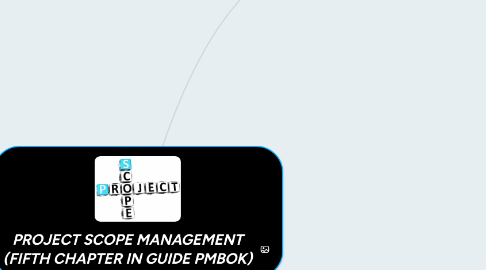
1. INTRODUCTION
1.1. PRODUCT SCOPE
1.1.1. Covers the required features of the product and clarifies the boundaries what is not included.
1.2. PROJECT SCOPE
1.2.1. is concerned with the work of the project, and again clarifies the boundaries of what is not included.
2. THE END
3. IT CONSISTS OF FIVE PROCESSES
3.1. COLLECT REQUIREMENTS
3.1.1. INPUTS
3.1.1.1. Project charter
3.1.1.1.1. it is used to provide
3.1.1.2. Stakeholder register
3.1.1.2.1. it is used to identify stakeholders that can provide information on detailed project and product requirements
3.1.2. TOOLS &TECHNIQUES
3.1.2.1. Interviews
3.1.2.1.1. it could be
3.1.2.1.2. PURPOSE
3.1.2.2. Focus groups
3.1.2.2.1. Pre‐qualified stakeholders & subject matter experts conform an interactive discussion guided for a trained moderator
3.1.2.3. Facilitates workshops
3.1.2.3.1. Focused sessions that bring key Cross‐functional stakeholders together to define product requirements
3.1.2.4. Group creativity techniques
3.1.2.4.1. Activities to identify project and product requirements
3.1.2.4.2. EXAMPLES
3.1.2.5. Group decision making techniques
3.1.2.5.1. It is an assessment process of multiple alternatives. These techniques can be used generate, classify and prioritize products requirements
3.1.2.5.2. EXAMPLES
3.1.2.6. Questionnaires and surveys
3.1.2.6.1. These are written sets of questions designed to quickly accumulate information
3.1.2.7. Observations
3.1.2.7.1. They provide a direct way of viewing people’s jobs or tasks and carry out processes.
3.1.2.7.2. Also called,
3.1.2.8. Prototypes
3.1.2.8.1. It is a method to obtain a feedback of a model product before building it
3.1.3. OUTPUTS
3.1.3.1. Requirement documentation
3.1.3.1.1. It describes how individual requirements meet the business need for the project.
3.1.3.1.2. It can include but are not limited to
3.1.3.2. Requirements Management Plans
3.1.3.2.1. It is how requirement activities will be analyzed, documented, and managed throughout the project
3.1.3.2.2. They can include but are not limited to
3.1.3.3. Requirements Traceability Matrix
3.1.3.3.1. It is a table that links requirements to their origin and traces them throughout the project life cycle
3.1.3.3.2. it can include but is not limited to
3.1.4. OVERVIEW
3.2. DEFINE SCOPE
3.2.1. INPUTS
3.2.1.1. Project charter
3.2.1.2. Requirements documentation
3.2.1.3. Organizational process assets
3.2.1.3.1. Examples include but are not limited to
3.2.2. TOOLS &TECHNIQUES
3.2.2.1. Expert judgment
3.2.2.1.1. It is often used to analyze the information needed to develop the project scope statement
3.2.2.1.2. SOURCES
3.2.2.2. Product analysis
3.2.2.2.1. It includes techniques such as
3.2.2.3. Alternatives identification
3.2.2.3.1. It is a technique used to generate different approaches to execute and perform the work of the project
3.2.2.4. Facilitated workshops
3.2.3. OUTPUTS
3.2.3.1. Project Scope Statement
3.2.3.1.1. It describes in detail the project’s deliverables and the work requiredto create those deliverables
3.2.3.1.2. includes
3.2.3.2. Project document updates
3.2.3.2.1. Project document that can be updated include but are not limited to
3.2.4. OVERVIEW
3.3. CREATE WBS
3.3.1. INPUTS
3.3.1.1. Project scope statement
3.3.1.2. Requirements documentation
3.3.1.3. Organizational process assets
3.3.1.3.1. They include but are not limited to
3.3.2. TOOLS &TECHNIQUES
3.3.2.1. Decomposition
3.3.2.1.1. It is the subdivision of project deliverables into smaller more manageable components until the work and deliverables are defined to the work package level.
3.3.2.1.2. It involves the following activities
3.3.2.1.3. Structure
3.3.3. OUTPUTS
3.3.3.1. WBS
3.3.3.1.1. it is a deliverable-oriented hierarchical decomposition of the work to be executed by the project team, to accomplish the project objectives and create the required deliverables, with each descending level of the WBS representing and increasingly detail definition of the project work.
3.3.3.2. WBS dictionary
3.3.3.2.1. It is a document created by the Create WBS process that support the WBS
3.3.3.2.2. The information includes but is not limited to
3.3.3.3. Scope baseline
3.3.3.3.1. It is a component of the project management plan.
3.3.3.3.2. COMPONENTS:
3.3.3.4. Project document updates
3.3.3.4.1. Project documents that may be updated include, but are not limited to requirements documentation
3.3.4. OVERVIEW
3.4. VERIFY SCOPE
3.4.1. INPUTS
3.4.1.1. Project management plan
3.4.1.1.1. Components of the scope baseline include:
3.4.1.2. Requirements documentation
3.4.1.3. Requirements traceability matrix
3.4.1.4. Validated deliverables
3.4.1.4.1. Validated deliverables have been completed and checked for correctness by the Perform Quality Process
3.4.2. TOOLS &TECHNIQUES
3.4.2.1. Inspection
3.4.2.1.1. It includes activities such as measuring, examining, verifying work in order to check if the products and deliverables fulfill the requirements & acceptable criteria
3.4.3. OUTPUTS
3.4.3.1. Accepted deliverables
3.4.3.1.1. Meet the acceptance criteria
3.4.3.2. Change requests
3.4.3.2.1. Deliverables that have not been formally accepted are documented, along with the reasons for non-acceptance
3.4.3.3. Project document updates
3.4.3.3.1. Project document that may be update as a result of verify scope
3.4.4. OVERVIEW
3.5. CONTROL SCOPE
3.5.1. INPUTS
3.5.1.1. Project management plan
3.5.1.1.1. The PMP contains the following information that is used to control Scope
3.5.1.2. Work performance information
3.5.1.2.1. It is information about project progress, such as which deliverables have started, their progress and which deliverables have finished
3.5.1.3. Requirements documentation
3.5.1.4. Requirements traceability matrix
3.5.1.5. Organizational process assets
3.5.1.5.1. They include but are not limited to
3.5.2. TOOLS &TECHNIQUES
3.5.2.1. Variance analysis
3.5.2.1.1. It is used to assess the magnitude of variation from the original scope baseline.
3.5.3. OUTPUTS
3.5.3.1. Work performance measurements
3.5.3.1.1. Measurements can include planned vs. actual technical performance or other scope performance measurements
3.5.3.2. Organizational process assets updates
3.5.3.2.1. Organizational process assets that may be updated include but are not limited to
3.5.3.3. Change requests
3.5.3.3.1. Analysis of scope performance can result in a change request to the scope baseline or other component of the PMP
3.5.3.4. Project management plan updates
3.5.3.4.1. – Scope baseline updates
3.5.3.4.2. – Other baseline updates
3.5.3.5. Project document updates
3.5.3.5.1. Project document that may be updated include but are not limited to
3.5.4. OVERVIEW
